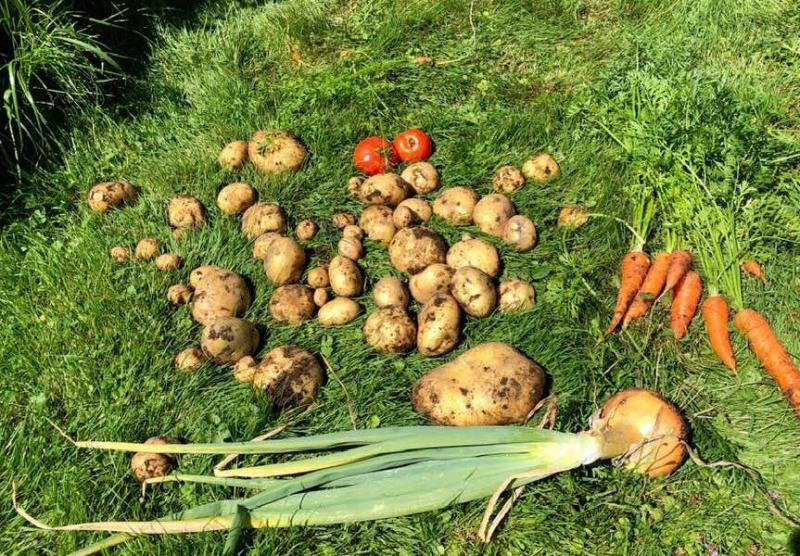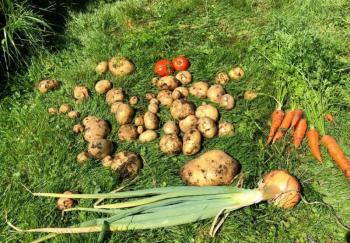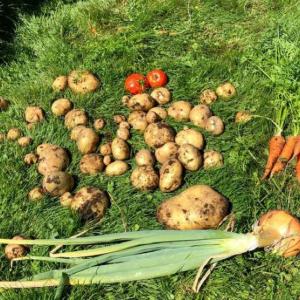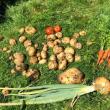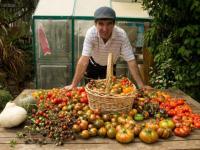This Week in Lincolnville: Putting It By
Labor Day and I started a fire in the woodstove, the first one of the summer. That after reluctantly closing all the windows which have been wide open for a couple of months. Since even the chilliest early morning is followed by the strong warmth of the midday sun, why bother closing, then opening nearly a dozen windows every day?
Maine has lived up to its billing this year as a place where you need a blanket every night. Maybe I’m forgetting that brief July heat wave; it didn’t last very long. But today, with heavy clouds overhead and rain in the forecast there’s a definite feel of fall in the air.
CALENDAR
MONDAY, Sept. 2
Schoolhouse Museum Open, 1-4 p.m., 33 Beach Road
TUESDAY, Sept. 3
Needlework and Knitting, 4- 6 p.m., Library
WEDNESDAY, Sept. 4
Schoolhouse Museum Open, 1-4 p.m., 33 Beach Road
Watercolor Journaling, 4-6 p.m., Library
Monarch Butterflies, 7 p.m., Library
THURSDAY, Sept. 5
Soup Café, Noon-1 p.m., Community Building, 18 Searsmont Road
Wage and Personnel Policy Board, 5 p.m., Town Office
FRIDAY, Sept. 6
Schoolhouse Museum Open, 1-4 p.m., 33 Beach Road
SATURDAY, Sept. 7
Intro to Pickleball and Open Play, 8-10 a.m., LCS Outdoor Courts, 523 Hope Road
EVERY WEEK
AA meetings, Tuesdays & Fridays at 12:15 p.m., Wednesdays & Sundays at 6 p.m., United Christian Church
Lincolnville Community Library, open Tuesdays 4-7, Wednesdays, 2-7, Fridays and Saturdays, 9 a.m.-noon. For information call 706-3896.
Soup Café, every Thursday, noon—1p.m., Community Building, Sponsored by United Christian Church. Free, though donations to the Community Building are appreciated
Schoolhouse Museum open M-W-F, 1-4 p.m.
Bayshore Baptist Church, Sunday School for all ages, 9:30 a.m., Worship Service at 11 a.m., Atlantic Highway
United Christian Church, Worship Service 9:30 a.m., Children’s Church during service, 18 Searsmont Road
COMING UP
Sept. 10: Oldtimers Luncheon
Sept. 15: Violettes Gospel Group, Bayshore Baptist Church
If you rely on a woodstove you’ve probably stockpiled the summer’s cracker and cereal boxes in the woodbox for the day when you’ll need firestarters. I had a small mountain of them filling up a corner of the kitchen, and now I can feed them into the stove one at a time, heating up the room for a couple of hours.
If September’s here, it’s time to start figuring out the tomatoes. And the onions, garlic, potatoes, corn and squash. The beans, peas, and spinach have been in the freezer for over a month already, along with the blueberries, and if we’d had extra, the raspberries.
Back in the day when most people in this town were farmers, putting the harvest by was a big deal. Green vegetables like my beans, peas, and spinach were only consumed in the few weeks of the summer that they were ripe. Ditto sweet corn. Once their tender green season had passed, they could only be preserved by drying.
Dandelion greens were liberally salted and put down in crocks; shredded cabbage fermented to sauerkraut in the same way.
Potatoes, carrots, beets, and turnips were kept in a root cellar under the house where the temperature was ideally around 40. Squash and pumpkins kept for a while under the bed, dry and cool.
Meat – pork and beef – was eaten fresh when slaughtered, the rest brined and smoked or salted down in crocks. A side or haunch of a beef critter or pig would be hung in the barn or shed, frozen solid and pieces hacked off until it was gone.
Milk could be preserved as either cheese or butter. The butter was packed in salt and lasted quite a while. Cheese involved a more complicated processing; not everyone had the equipment or expertise in this art.
Apples were sliced and dried for future pies or pressed into cider which had its own life cycle, eventually ending up as the alcohol of choice for many New Englanders.
Pickles, jams and jellies, preserves of all kinds were probably the work of a farm wife with access to sugar and spices and the jars and kettles needed to put them up.
Remember that all this food preservation was done without benefit of running water, plastic containers, gas or electric stoves, and refrigeration. Yet today’s gardeners use many of the same techniques as those farmwives of a hundred, even two hundred years ago.
In this my 50th (or 49th or so) year of harvesting I’ve figured out what works for me. The two earliest crops are dandelion greens and asparagus.
I dig a large basketful of dandelions on one day, just as the buds are showing in the center of the plant, but before they send up their stems. Slice through the root just under the soil with an old knife kept in the shed for just this purpose and pull up the plant. Trim the root close to the rosette of leaves and brush off as many pine needles, dirt and other debris as you can, then layer them in the basket. Taking the time to clean off things outside saves a bundle when you get to the sink.
Resign yourself to a couple of hours with hands submerged in icy water as you clean the greens. It’s slow and I always imagine what it was like when the water had to be pulled up from a well or dipped out of a stream. I do enough to fill a two-gallon ziplock bag; they keep for a couple of weeks in the fridge. Steam them with chopped up bacon, then sprinkle with vinegar. A poached egg on top makes it a meal.
Asparagus is easy. Pick and eat it every day from mid-May till July 4. If you can’t keep up with it, give it away.
Spinach comes next. I eat it in salads and add it to everything I cook, then pull it all just before it bolts, sometime in June usually. I make an enormous batch of creamed spinach (white sauce plus mustard and chicken base) with the blanched-wilted spinach stirred in, then freeze it in those tiny snack bags, each enough for one serving.
Peas are simple but tedious. Unless, that is, you can sit outdoors with a spouse or a friend or some favorite music playing while you shell the mountains of pods that come in every other day or two. Drop them in boiling water until they float (about a minute) then into cold water, then strain and into a gallon freezer bag. You can add the newly-blanched ones to yesterday’s partly filled bag. They freeze together, but if you smack the frozen bag on the counter they break apart and you can scoop out a cup or two for supper.
Green beans come next in July. Pick them before the beans inside the pod start to swell, snap them into threes, and blanch for about a minute or two, then into cold water. Drain them and spread out on a dish towel to dry them off a bit, then in single layers on cookie sheets. Put them in the freezer over night, then scrape them into gallon bags. Easy to shake out just what you need.
Before you know it, summer’s half over and the zucchini is looking for attention. Forget about freezing it; you’ll never use it. Eat all you can, then make it into relish. People bought several jars of Ruth Felton’s delicious zucchini relish every time it showed up on a United Christian Church flea market or Strawberry Festival sale table. Some had a standing order for it every summer.
I had several failures making sauerkraut in a crock until my friend Margaret Page showed me the way Mildred Flagg had taught her to make it in the old baling wire glass jars. Shred the cabbage, mix in three and a half tablespoons of pickling salt per five pounds of cabbage. Pack it into the pint jars, a pound per pint, put on the top, but leave the wire loose. Let it ferment for three weeks or so, then snap down the wire. I keep mine in the fridge, but a cool cellar works too.
As of Labor Day 2019 I’ve also dug and cleaned the garlic crop: 12 pounds! Most of the onions are pulled and drying on the aluminum saucers my boys used to fly down our pasture hill. As the tops dry I twist them into baling twine ropes, six pounds to a string, and hang them in the shed to finish curing, then into the cellarway where we, my upstairs family and I, go “shopping” for such things. As I do every year, if you have onions to store, stop by and I’ll show you how to make onion strings, a trick I learned many years ago from Judie Hazen.
A bag of summer apples from John Pincince’s orchard ended up the other day as jars of applesauce in my pantry. He has several other apple varieties for sale, as well as plums. The blueberries Hannah Burke rakes on Appleton Ridge take up another shelf in my freezer, handy to grab a handful every morning for my cereal.
We’ve had spotty corn this year; the early corn is puny, pale and weak-looking. The later variety looks better, but only marginally so; we may get a few decent ears from it. The popcorn, though, is tall, dark green and vigorous. We’ll leave that to dry on the stalk, then husk the ears and dry them further inside. There ought to be at least a year’s worth of kernels for the six of us.
Normally I blanche the ears of sweet corn, then cut the kernels off the cobs and freeze it in bags, one cup portions. Not this year.
Beets, carrots, Brussels sprouts, potatoes, red cabbages are still to come. All these, including the alien-looking stalks of Brussels sprouts, go into the root cellar. Since we had our cellar encapsulated several years ago, the rock walls and dirt floor covered with spray on insulation and heavy white plastic, it’s been too warm down there for a traditional root cellar. Instead, I built an insulated box that backs up against a portion of the original rock wall. All that cold air coming in through the earth keeps the box cold enough for storage.
Doesn’t Mr. Hannaford carry all the above and more? Well sure, but I’d much rather rummage around in my box of earthy-smelling potatoes at suppertime or pull out a little plastic bag of my own creamed spinach. Wouldn’t you?
School Starts Tomorrow!
With a third, a fourth and a sixth grader living upstairs I’m definitely aware that tomorrow’s the first day of school at LCS.
As David Kinney wrote in an LBB post a few days ago: “Please keep an eye out for school buses and more importantly for the passengers as they load, unload and cross the street. This is an exciting time and sometimes in the excitement kids forget to look.
“And remember that the speed limit on the Hope Road is reduced for several minutes in the morning before school starts and for several minutes after school lets out in the afternoon.”
Library
Bring a needlework project to the Library Tuesday afternoon and bring a friend, come to learn, to laugh, to visit. Newcomers and all skill levels welcomed. Meets the first, second and fourth Tuesday of each month.
On Wednesday September 4 it’s Watercolor Journaling from 4–6 p.m.
Everyone is welcomed—bring your own supplies and we’ll supply the smiles. Meets every first and third Wednesday.
Then Wednesday evening at 7p.m. Maine Master Naturalist Cyrene Slegona will give a free illustrated talk on monarch butterflies and the science of their migration on Wednesday, This past February Cyrene, who has observed and studied monarchs since she was twelve, visited several of their overwintering sites in Mexico. She will present historical information on the monarch, Daneaus plexipus plexipus, and tell about current and proposed research on this butterfly. There will also be a review of its life cycle and behaviors. Attendees will learn about the best hand-rearing practices and the importance of native milkweeds and end-of-season migrator-friendly gardens.
Friday, the first Friday of the month, is Family Music with Jessica Day, 11 a.m. to noon. Children (toddlers to 5 years old) and their families are invited to this lively and free program playing instruments, dancing and singing. Offered every first Friday of the month.
Feeding Bike Maine
Next week Lincolnville’s Community Building will be a lunch stop for some 500+ riders cycling from Rockland to Belfast. United Christian Church volunteers are putting on a spaghetti lunch featuring marinara/meatball sauce from Dolce Vita Farm, salad fixings from 3 Bug Farm and bread from Dot’s.
Oldtimers Luncheon
This year’s Oldtimers Luncheon will be held Tuesday, September 10, at the Lobster Pound. “Oldtimers” is a loose definition; basically, if you live in Lincolnville or summer here you’re welcome to come. If you didn’t receive an invitation in the mail with its RSVP card, call someone on the committee – Janet Plausse, 789-5811, Barbara Marsh, 593-8661, Peg Miller, 763-3381, or Rosemary Winslow, 763-3343 – and let them know you’d like to come. They’ll tell you the menu choices as the Pound needs an estimate of menu choices.
Event Date
Address
United States

